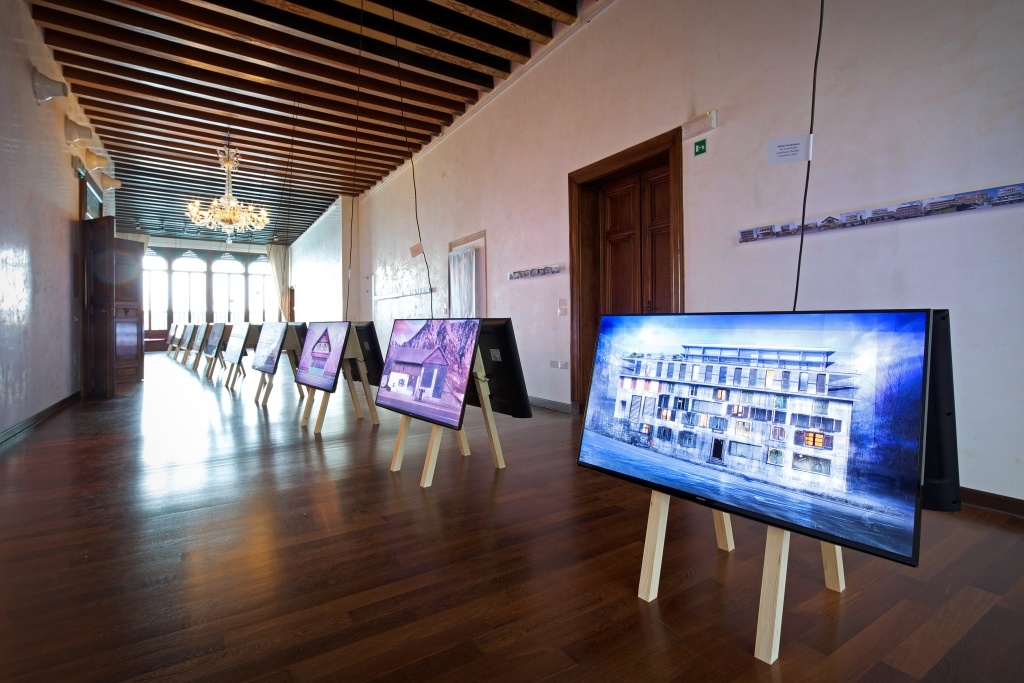Last Friday saw the opening of the exhibition ‘Once upon a time in Liechtenstein’ at the Architecture Biennale in Venice. This had been planned by the University of Liechtenstein, and was accompanied by an international symposium. The exhibition continues in Venice until 26 October 2014, and will be shown at the Liechtenstein Museum of the Fine arts from 6 November.
University of Liechtenstein organises Liechtenstein’s first appearance at the Architecture Biennale in Venice

The exhibition ‘Once upon a time’ at the Palazzo Trevisan degli Ulivi, Venice
Around 200 persons, from Liechtenstein and all over the world, took part in the opening of the exhibition on Friday evening and the symposium at the Palazzo Trevisan degli Ulivi on the following day. ‘We were very surprised by the large numbers of visitors. This testifies to a major public interest in this event, which is an important one for Liechtenstein as well, and evidently also in the themes which the exhibition illustrates,’ commented the curator of the exhibition, Peter Staub, Associate Professor for Architecture and Visual Culture at the University of Liechtenstein.
The exhibition consists in ten projects by international students at the University of Liechtenstein, who had spent six months observing and analysing the building culture of the principality. The results can be viewed in the main hall of the Palazzo – 20 subtle animated pictures of typical Liechtenstein buildings, which only prove fictional when inspected at close quarters. The adjoining room, known as the ‘Atelier’, shows models and documents illustrating the students’ working process, as well as their visions of ways in which the buildings might be developed in future.

The curatorial board: Peter Staub with his team, Vera Kaps and Celina Martinez
The exhibition: architecture as the mirror of society
The starting point for the exhibition was the theme of this year’s Architecture Biennale, under the directorship of Rem Koolhaas – ‘Fundamentals’. In an age of globalisation, this is aimed at identifying the fundamental buildings styles of different countries and regions, as a basis for a critical survey of the modernism of the twentieth century.
Against this background, students of the University of Liechtenstein coming from Japan, Russia, Hungary, Germany, Spain, Georgia and Iran set out to discover the characteristically Liechtensteinian building culture. They were not concentrating on historic buildings like the Walser settlements so much as on the unobtrusive architectural offerings of everyday – as witnessed in petrol stations, banks, barns or private houses by the side of a country road.
This resulted in pictures of buildings which we all imagine we must have seen before, but which in fact do not exist. They reflect the habits of society and its ways of relating to the constructed environment. The exhibition poses critical questions, and is aimed at stimulating debate on architecture and spatial development in the principality.
‘I was very much impressed by the exhibition. It asks critical questions about our identity, while at the same time focusing on ways in which this identity may develop in future,’ said Government Councillor Dr Aurelia Frick, Liechtenstein’s Minister of Foreign Affairs, Education and Culture.

Exhibition opening: Andrea del Mercato of the Biennale, Peter Staub of the University of Liechtenstein, Andrew Holland (Pro Helvetia), Sandi Paucic (Pro Helvetia), Government Councillor Dr Aurelia Frick and Massimo Baggi (Swiss Consul General in Milan)
Symposium: how do global architects and local building cultures fit together?
The symposium on the Saturday, under the title ‘Where are you coming from?’, looked into the role of global architects and the way they deal with local contexts. Six promising young architects, academics and pioneering thinkers from Asia, Europe and America, including Kathrin Aste, Ute Schneider and Andri Gerber of the University of Liechtenstein, discussed the effects which the plethora of architectural influences in the world can have on a local building culture.
Among the speakers was the architect Stefano Rabolli Pansera, who won the Golden Lion at the 2013 Biennale for the best national pavilion. Other speakers were Christopher Lee, a Harvard professor whose firm Serie Architects has offices in London, Mumbai and Beijing, and the American Eric Schuldenfrei, a professor at Hong Kong University.
‘The architects of today all to some degree originate elsewhere. I come from one place, I work in another place on projects from somewhere else altogether. In our work we concentrate on typologies, on typical elements and ideas which are to be found in a certain context like that of a city. We start by identifying irreducible structures, with a view to transforming them and adapting them so as to conform with today’s expectations,’ said Professor Lee, who originally comes from Malaysia, explaining his approach.

Symposium: from left to right – Ute Schneider, Andri Gerber, Kathrin Aste and Peter Staub of the University of Liechtenstein
Liechtenstein networking on the international stage
Liechtenstein’s first appearance at the Architecture Biennale in Venice has demonstrated that this small principality in the heart of Europe, notwithstanding – or perhaps even because of – its diminutive size, is well able to make a contribution to global discussion of the future of local building cultures. At the same time, the concomitant networking with other countries and institutions can lead to important realisations. It is to be hoped that Liechtenstein will continue to be a powerful presence at the event in future years. At once sensitive and critical, this first presentation of the University of Liechtenstein whets the appetite for more.
Visiting the Liechtenstein Museum of the Fine Arts
Following the exhibition at the Palazzo Trevisan degli Ulivi in Venice, natives of Liechtenstein will have the opportunity of viewing it in their own country. Liechtenstein’s contribution to the Architecture Biennale will be shown at Kunstmuseum Liechtenstein [the Liechtenstein Museum of the Fine Arts] from 7 November 2014 to 6 January 2015. The private view takes place on 6 November.

Private view: Government Councillor Dr Aurelia Frick, talking to Thomas Soraperra of the Liechtenstein Museum of the Fine Arts and Ernst Risch (Liechtenstein Marketing)
Further information may be found at www.uni.li/biennale.
